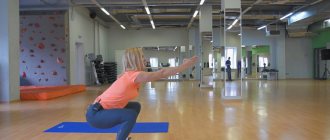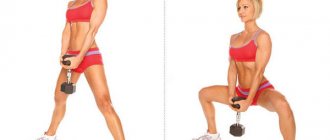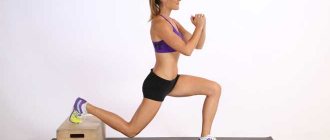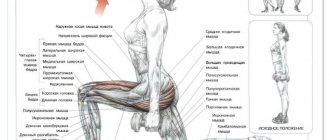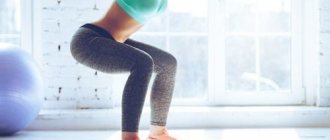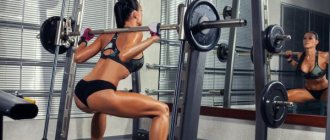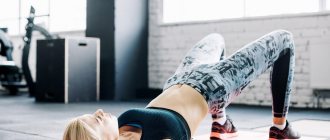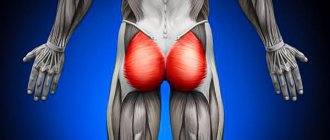The author of the Strength & Conditioning Research resource, Chris Beardsley, decided to answer the question of many trainees - is it possible to achieve maximum development of the thigh muscles through barbell squats alone. The editors of Zozhnik decided that they should not deprive their readers of such interesting information. Let's give the floor to Chris.
From time to time on the forum people ask: “What is the best way to plan a workout to develop the muscles of the lower body?” One well-known athlete gave a short recommendation: “Just squat.” But is it really possible to achieve optimal thigh muscle development by squatting alone?
What does "Just Squat" mean?
If you take this phrase literally, it could mean that all you need to develop your legs is squats and nothing else.
But some people, when they say “Just squat,” mean working all the muscles except the hamstring group (so calf curls are not excluded from the workout in this case). Sometimes this recommendation is also given by those who, in addition to squats, do deadlifts or glute bridges. In their understanding, the phrase “Just squat” refers only to the quadriceps.
Regardless of the context that is put into this recommendation, I suggest considering 2 questions:
- Are squats a good exercise for developing hamstrings?
- Are squats effective for developing all heads of the quadriceps muscle?
Bodyweight squats: video
How to do bodyweight squats. Technique
- Stand shoulder-width apart. Keep your arms in front of you or along your body, knees slightly bent. Keep your back straight. This will be the starting position.
- Squat down until your thighs are parallel to the floor. Stretch your arms forward. In movement, the body leans forward and the pelvis moves back. As you squat, take a breath.
- Rise to the starting position with your arms down. As you rise, exhale.
- Repeat the movement 20 times with 1 minute rest for three sets.
How to do bodyweight squats. Technique
Application of the exercise
For whom . To all aspiring men and women.
When . Bodyweight squats are best performed at the beginning or end of a leg workout. After squats, do leg curls in a lying machine and leg straightening in a machine.
How many . The exercise should be done in 3 sets of 15-20 repetitions.
Muscles of the back of the thigh: “Squat, but don’t forget about the deadlift?”
Fitness professionals know that squats are very effective for developing the quadriceps, adductor magnus and gluteus maximus muscles, but are not very effective for developing the hamstrings (Wright et al. 1999).
This is why a variety of deadlift variations (plus other exercises) are always included in a good training program to target the posterior chain muscles (those located on the back of the body)*.
To support the opinion that squats are incapable of properly loading the muscles of the hamstrings, we present the following data:
- Increasing the weight on the barbell in the squat does not increase hamstring activation , but does significantly increase quadriceps and gluteus maximus activation (Li et al. 2013).
- Lowering into a deeper squat with the same load does not increase hamstring activation , but does increase quadriceps and gluteus maximus activation much more (Gorsuch et al. 2013; Contreras et al. 2015b).
Why do the muscles of the back surface weakly engage during squats?
If we consider this issue from a biomechanical point of view, then, most likely, weak activation of the posterior muscles during squats is due to the fact that these muscles are bi-articular. They work as both hip extensors and calf flexors.
So, when you lower yourself into a squat (flexing your hip and shin), the muscle contracts closer to the knee but stretches closer to the hip joint. Roughly speaking, its length remains almost unchanged. When you rise from a squat (extending your hip and lower leg), the opposite happens - the muscle stretches closer to the knee, but contracts near the hip joint. Again, its length remains almost unchanged. This makes the hamstrings less effective as hip extensors during squats.
You might say, “I don’t care what the research says about lack of activation, I can feel my hamstrings firing when I squat.” And, of course, I will not argue with this.
You should really feel the muscles in the back of your thigh working during squats - that's where the adductor magnus is located. This is a very large muscle that is an important hip extensor during squats. It is located next to the muscles of the back surface, so in most cases you feel its work.
Benefits of Squats for Fitness and Form

The following popular statements are true:
- Squatting helps build muscles throughout the body. You don't necessarily need to do an overhead squat or try to do an overhead squat. In fact, movement helps build tight muscle corset on another level. Squatting causes a powerful hormonal response, and the body after it is more ready for training load and muscle building than without it. For this reason, by the way, beginners are recommended to train for the whole body; small muscles will receive enough “hormonal support” from their own body, and the process will go more naturally and faster;
- training with a heavy squat is better for losing weight than training with a bunch of swings and isolated abductions on the buttocks. The simple principle of “income and expenditure” works here. The more adequate the calorie deficit is, the faster a person will lose excess weight. And the easier it will be to create it without tricks like 40 minutes of running after each workout, the more muscles are involved in the process of the workout itself. During a back squat, the back and abdominal muscles work as stabilizers, and all the muscles of the “lower half” of the body are actively involved;
- squats should be performed in sufficient volume, but they do not replace deadlifts, lunges, bench steps and other good exercises for the lower body;
- without proper and heavy squats, it is difficult to achieve even average strength indicators in most exercises (true for women and natural training);
- in cases where the squat is contraindicated for surgical or orthopedic reasons, it is better not to do it. You can maintain tone with other movements, but you shouldn’t risk your health for the sake of results in the gym.
Squats and quadriceps femoris
The quadriceps consists of 4 muscles located on the front of the thigh. By the way, just recently scientists discovered a new muscle, which they called the “tensor vastus intermedius” (Grob et al. 2016).
While researchers work through updating anatomical nomenclature, we will recall the names of the four main muscles of the quadriceps:
- Vastus lateralis muscle,
- Vastus medialis muscle,
- Vastus intermedius muscle
- Rectus muscle.

Of the four muscles of the quadriceps, all except the rectus muscle are single-joint muscles, the only function of which is to extend the lower leg. The rectus femoris is a biarticular muscle that, in addition to straightening the lower leg, flexes the thigh.
Now let’s see how much, in percentage terms, the physiological* cross-sectional area of each quadriceps head occupies (as you can see, each of the 4 muscles makes a significant contribution to the total volume of the thigh):
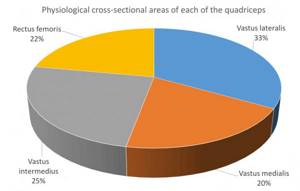
Vastus lateralis - vastus lateralis, Vastus medialis - vastus medialis, Vastus intermedius - vastus intermedius, Rectus femoris - rectus femoris.
It makes sense that if we are looking for maximum thigh muscle development, we need to make sure that the exercises we use target all 4 heads of the quadriceps.
Does the rectus femoris muscle grow from squats?
Squats have always been considered the best exercise for overall development of the quadriceps muscles, which has been confirmed in studies . In 1994, Signorile et al. studied the degree of electromyographic (EMG) activation of the vastus lateralis and vastus medialis muscles during squats and calf extensions in a machine. It was squats that showed higher EMG activation of the muscles studied.
A 2009 experiment (Ebben et al.) once again confirmed that in terms of development of the vastus lateralis muscle, squats are more effective than calf extensions, as well as deadlifts and step-ups.
On the other hand, as another experiment from the same year showed (Ebben et al.), during calf extension in the machine, there is a higher activation of the rectus femoris muscle compared to squats.
A very important study was conducted in 2015 (Fonseca et al.), in which 2 groups of participants trained in different patterns over a long period. One part of the subjects only squatted, while the other did several exercises: squats, leg presses, deadlifts and lunges. The group that trained with variety had hypertrophy in all 4 heads of the quadriceps, including the rectus femoris. In those who only squatted, only 3 single-joint heads of the quadriceps increased in volume.
Again, the lack of hypertrophy of the rectus femoris in squatters is due to the fact that it is both a hip flexor and an extensor of the leg.
As you lower into the squat (flexing the hip and shin), the rectus muscle stretches closer to the knee but contracts closer to the hip joint. As is the case with the muscles of the back of the thigh, its length remains almost unchanged. When moving upward from a squat (the thigh and lower leg extend), the rectus muscle contracts at the knee, but stretches near the hip joint. The result is the same - in the direction of movement its length practically does not change. It turns out that the rectus femoris muscle is very weakly involved in the work during squats.

As already mentioned, the degree of activation of the rectus femoris muscle is much higher during leg extension in the simulator.
The rectus muscle appears to increase in size more readily when performing this single-joint exercise when compared to the rest of the quadriceps heads (Ema et al. 2013).
This is how hypertrophy of the quadriceps heads occurs after systematically performing calf extensions.
Change in the anatomical cross-sectional area of the quadriceps muscles after calf extensions in the simulator:

From left to right – vastus lateralis, vastus medialis, vastus intermedius and rectus femoris.
Proximal (proximal) – located closer to the place of attachment of the limb to the body (in our case, the muscle section closer to the hip joint).
Distal (distal) - located further from the place of attachment of the limb to the body (in our case, closer to the knee).
Apparently, the rectus femoris muscle works most actively in exercises where simultaneous (and relatively equal in amplitude) flexion of the thigh and lower leg does not occur.
The benefits of squats without weights
The very first thing that awaits any beginner in a proper weight room is learning how to squat without weights. To begin with, the trainer will ask you to sit down as comfortably as possible. And you will repeat what you repeat day after day - place your feet at a comfortable width and abduct your pelvis. You won't even think about two key points that are important for proper squatting:
- the body should be stable, the shoulder blades should be tight, the arch in the lower back should be natural, and the stomach should not rest on the hips;
- squatting is flexion and extension at the hip and knee joints. Emphasis on only one articular group is unacceptable.
Most beginners will squat without thinking about the position of their back and stomach, and will try to gain depth through extreme knee bending.

How to learn to squat with the correct body position? There are several options:
- classic squat with wide foot placement “chest against the wall”. At the same time, the arms are raised upward, palms on the wall. The goal is to lower your pelvis as low as possible. The wall will not allow the position of the body to be distorted;
- classic squat with a gymnastic stick. The stick is held with the hands above the head, the technique is the same;
- squatting with wide feet on a low box, with a gymnastic stick in your hands (over your head). There is no need to “sit” on the box, as strength athletes do when training power. You just have to touch it lightly and get up again.
The main mistake in squats “of all times and peoples” is an attempt to solve some particular problems without mastering the technique of the basic exercise. Let's say a girl wants to pump up her buttocks and lose excess weight. Somewhere on a social network she reads that 100, or better yet, 200 squats a day will help her solve this problem. And he begins to squat, increasing his “habits” of incorrect movement. Why so categorical? Yes, because an untrained person will not do 100 squats in pure technique without a break, unless, of course, he miraculously runs a 15-20 km distance and again miraculously never squats.
You need to go gradually to develop form and technique. And while you are gradually walking, for the same pumping up of the buttocks, it is advisable to use isolating exercises in machines or with weights (swings, flexions, abductions). But the emphasis in training should be shifted towards squats. At the beginning of the lesson, we teach the technique, and only then we “wave” 3 x 15 or 4 x 20, or whatever is prescribed to you by the trainer.
Again, there is no need to panic that you won’t be able to lose weight with squats. At this level of physical fitness, the problem will still have to be solved primarily through diet. Therefore, you shouldn’t invest too much in trying to burn calories by squatting.
